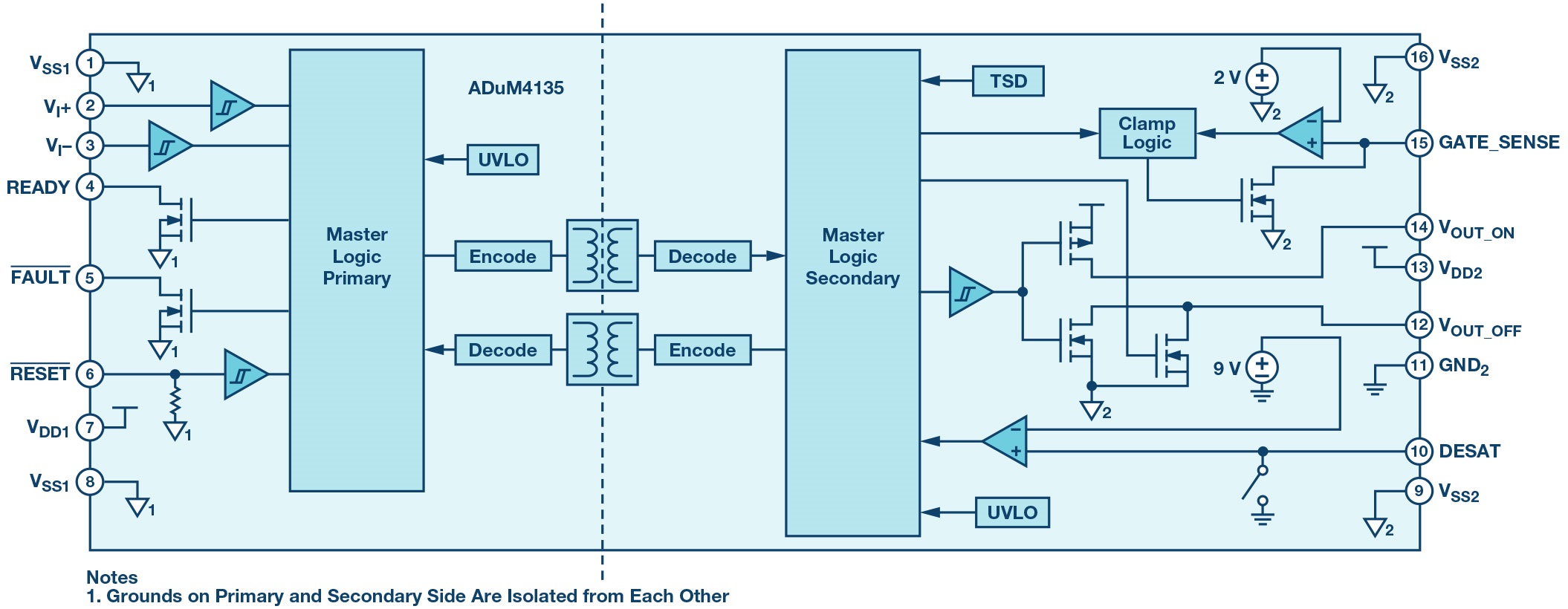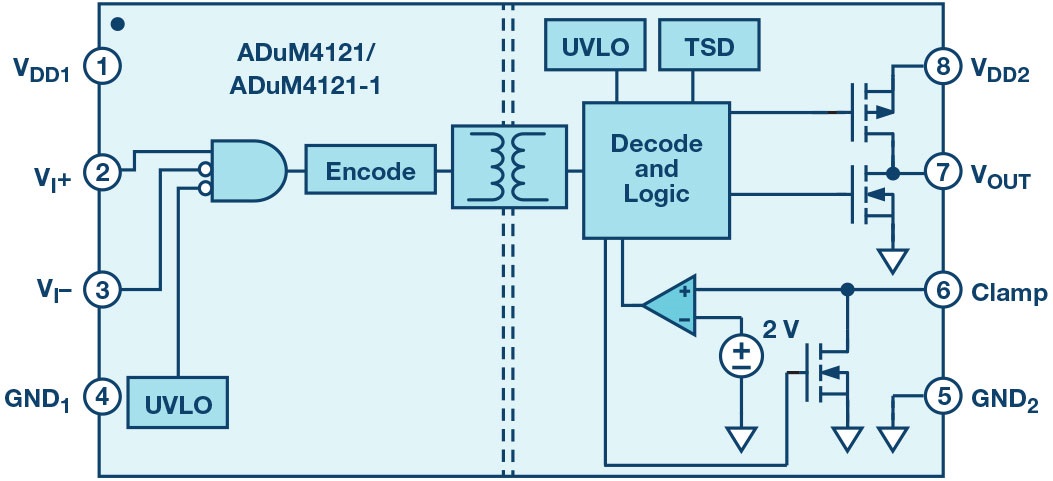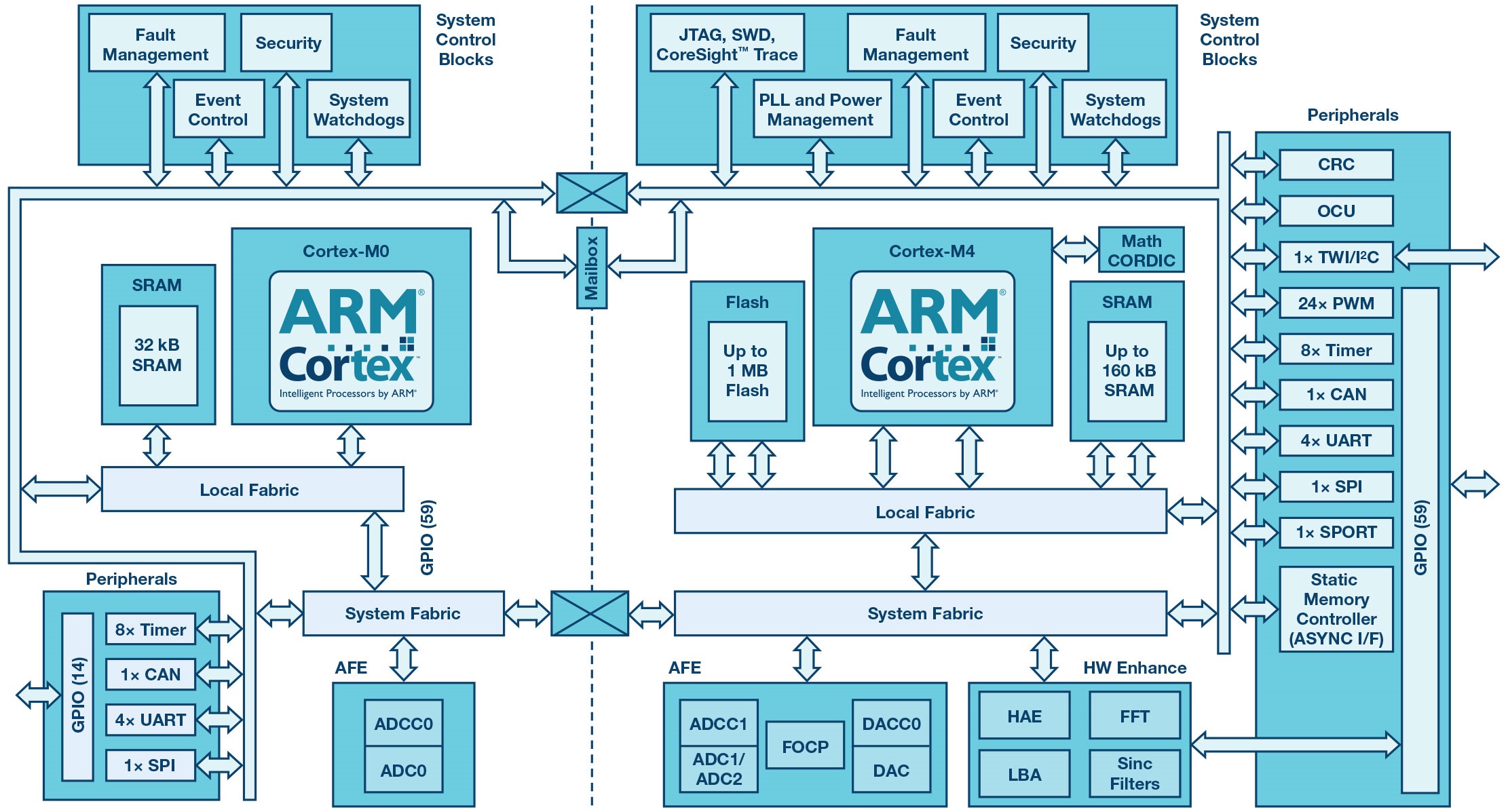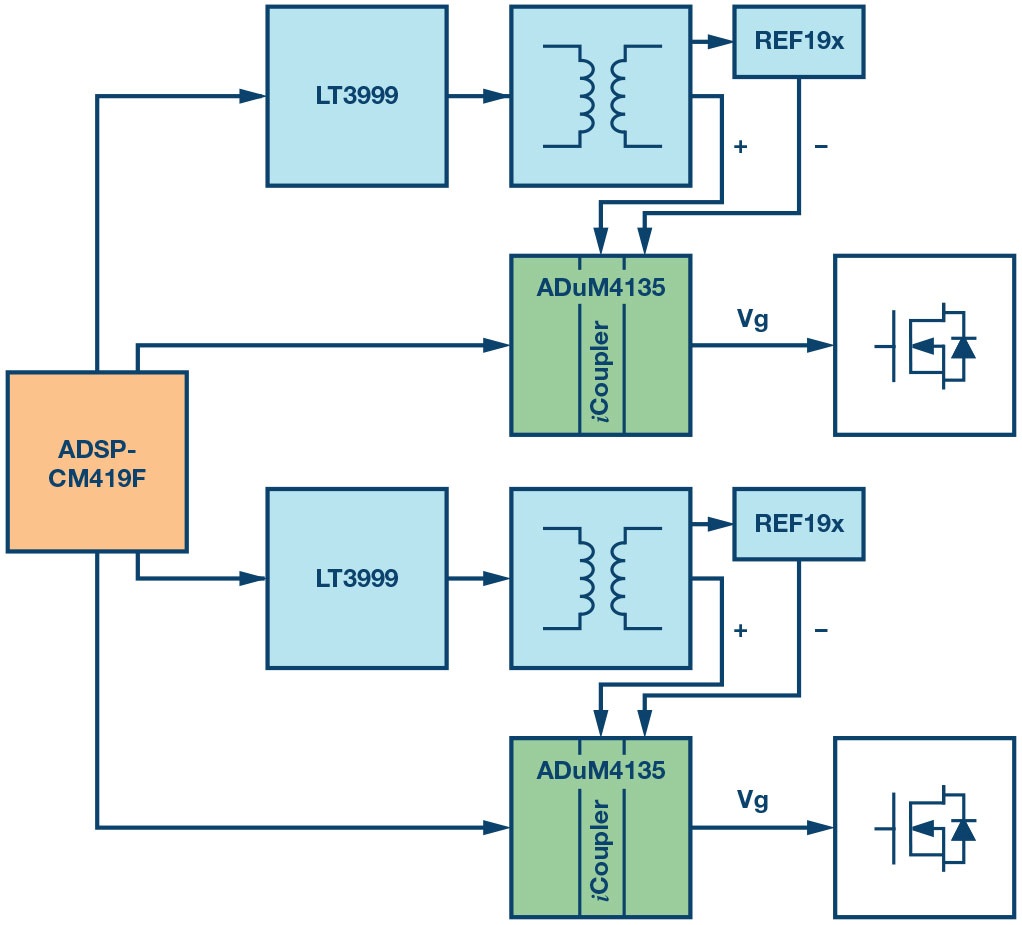Driving leading-edge SiC/GaN power converters
To take advantage of the new power switch technologies, a complete ecosystem of ICs must be implemented in converter design, starting with the gate driver, says Stefano Gallinaro, Analog Devices and Imad Owaineh, Watt&Well
The evolution of the power converter market brings new challenges, such as the need to make smaller and more efficient power converters that can serve smaller servo drives or be integrated into distributed energy storage units. This also means having higher working voltage to manage higher power without increasing weight and dimension, like in solar string inverters and electric vehicle tractionmotors.
New high efficiency, fast power converters based on wideband gap (WBG) semiconductors like silicon carbide (SiC) and gallium nitrite (GaN) MOSFETs are expanding in various markets and applications, namely solar PV inverters, energy storage, and vehicle electrification.
Requirements for isolated gate drivers are also changing. For SiC and GaN MOSFETs, high CMTI >100 kV/μs, wide gate voltage swing, fast rise and fall times, and a very low propagation delay are needed. ADI’s ADuM4135 isolated gate driver has all the required technical features integrated in a 16-lead, wide-body SOIC package. Together with the ADSP-CM419F high end, mixed-signal control processor, both can manage the high speed, complex multi-level control loops of the high density, SiC-/GaN-based, next-generation power converters.
Technology advances
The leading applications driving the use of SiC/GaN power switches are solar PV inverters,electrical vehicle chargers,and energy storage converters. The fast,small,and efficient power switches bring to the market extremely high switching frequencies and efficiency targets of more than 99%. To achieve these results, designers are faced with reducing the weight and footprint (i.e. increasing the power density) of the power converters.
 Figure 1: ADuM4135 block diagram
Figure 1: ADuM4135 block diagram
Moving towards high voltage (HV) systems compatible with WBG semiconductors presents its own challenges. Firstly, HV implicates lower currents, which means that the total copper in the system will be reduced. This reduction has a direct impact on thecost reduction of the system. Secondly, wide gap technologies (enabled by HV) generate less resistive losses, which present better efficiency and reduce the size and need for a cooling system. Finally, on a sub-system level,they will enable engineers to move from baseplate power module-based designs to discrete-based or lighter power module-based designs. This implies using compatible PCBs and smaller wires,instead of busbars and heavier wires.
The high breakdown voltage of 1.7kV and 3.3kV SiC MOSFETs is becoming a standard for second level applications,while the1.2kV SiC MOSFETs are the mainstream power switches for next-generation second and third level applications.
Advantages of SiC/GaN
The considerabled V/dt switching,in herent to WGB semiconductors, represents very little loss/switch. This makes a high switching frequency (50 to 500kHz for SiC, or >1MHz for GaN) a realistic possibility, which helps decrease the magnetics volume while increasing the power density.A reduction of more than 70% in the inductor value, size, and weight, together with reduced capacitors, can bring a final converter down to 20% of the size and of weight of a traditional one. The savings in passive components and mechanics (including heat sink) are about 40%, with the added value being on the control electronics ICs.
Another advantage of these technologies is their tolerance to high thermal junction temperatures. This helps with increasing power density, while also limiting cooling problems.

Figure 2. ADuM4121 block diagram
Other characteristics of SiC/GaN switches that help reduce the losses are the absence of any recovery on the diodes (fewer losses on rectification), and the low Rds(on) (which generates less conduction) losses, in addition to their HV operation.
These advantages enable designing and implementing new and innovative power electronics topologies for new applications. SiC/GaN power switches are beneficial in designing resonant circuits (such as LLC or PRC) or bridge topologies (phase-shift full bridge) or bridgeless power factor correction, due to high switching frequencies, efficiency (thanks to zero voltage switching and zero current switching), and consequently high power density.
SiC/GaN power transistors enable multi-level power conversion stages and full bi-directionalworkingmodes,where silicon IGBTs have limitations because of reverse operation.
The need of bi-directional working modes is becoming mandatory for applications like energy storage, where the power flows to and from the batteries to the loads or to the grid. The possibility of designing high power converters with compact housing also allows a distributed energy storage system, where battery charging accuracy can be higher.
SiC/GaN design challenges
Driving SiC MOSFETs raises newconsiderations such as the negative bias (needed for the gate driver) and the accuracy of the driving voltage (this is even more important for GaN). There is little tolerance for such imprecision.
Analog Devices’ iCoupler isolated gate drivers combine high bandwidth on-chip transformers and fine scale CMOS circuitry that improve reliability, size, power, speed and timing accuracy. The company’s digital isolators use low stress, thick film polyimide insulation to achieve thousands of volts of isolation that can be monolithically integrated with standard silicon ICs and can be fabricated in single-channel, multi-channel, and bi-directional configurations: 20 to 30μm of polyimide insulation withstand >5kVrms.
 Figure 3. ADSP-CM419F block diagram
Figure 3. ADSP-CM419F block diagram
Using iCoupler technology, the ADuM4135 isolated gate driver is considered the best choice for driving SiC/GaN MOS, due to a propagation delay of better than 50s with channel-to-channel matching of less than 5ns,common-mode transient immunity (CMTI) of better than >100kV/μs,and the capability to support lifetime working voltages of up to 1500V DCin a single package.
The ADuM4135, in a 16-lead, wide-body SOIC package, includes a Miller clamp to provide robust SiC/GaN MOS or IGBT turn-off with a single-rail supply when the gate voltage drops below 2V.Operation with unipolaror bipolar secondary supplies is possible. A desaturation detection circuit provides protection against high voltage, short-circuit switch operation. The desaturation protection contains noise reducing features,such as a 300ns masking time after a switching event to mask voltage spikes caused by initialturn-on. An internal 500µA current source allows for a low device count and the internal blanking switch allows for the addition of an external current source if more noise immunity is needed. The secondary UVLO is set to 11V, with common IGBT threshold levels taken into consideration. iCoupler chip scale transformers also provide isolated communication of control information between the high voltage and low voltage domains of the chip. Information on the status of the chip can be read back from dedicatedoutputs.Thecontrolforresettingthedeviceafterafaultonthe secondary is performed on the primary side of thedevice.
For more compact and simpler topologies (for example, GaN-based half bridges), the ADuM4121 isolated gate driver is also based on iCoupler digital isolation. It features a low propagation delay of 38ns,which allows for high switching frequencies and common-mode transient immunity of 150kV/μs. It provides 5kVrms isolationin a wide-body, eight-lead SOIC package.
Under high voltage and high frequency conditions, no capacitive or inductive parasitic elements should be tolerated at all. Special care should be taken when routing the boards and defining the layout to avoid EMI and noise issues. WBG semiconductor design requires high voltage and high frequency passive components (magnetics and capacitances), brining sizing, designing, andmanufacturing challenges.
Although WBG semiconductors are effective for implementing high efficiency, high density topologies, and resonant topologies, these topologies are complex. For example, the number of inputs needed to regulate a resonant topology,combined with frequency modulation and phase modulation (on very high frequencies),do not make the engineer’s task any easier. The choice of digital components (DSP, ADC) is of utmost importance as well.
The system control units (generally a combination of MCUs, DSPs, or FPGAs) must be able to run multiple, high speed control loops in parallel and manage safety features. They have to provide redundancy and a large number of independent PWM signals, ADCs, and I/Os. The ADSP-CM419F enables designers to have one mixed-signal, dual-core processor managing parallel high power, high density, mixed-switch, multi-level power conversion systems.
ADSP-CM419F is based on the ARMCortex-M4 processor core, with a floating-point unit operating at frequencies up to 240MHz. It incorporates an ARM Cortex-M0 processor core operating at frequencies up to 100MHz. This enables the integration of dual-core safety redundancy into a single chip. The main ARM Cortex-M4 processor integrates 160kbyte of SRAM with ECC, 1Mbyte of flash memory with ECC, accelerators, and peripherals optimised for power converters’ control, like 24 independent PWM, and an analogue module consisting of two 16-bit SAR type ADCs, one 14-bit on Cortex-M0 ADC, and one 12-bit DAC. The ADSP-CM419F operates from a single voltage supply, generating its own internal voltage supplies using internal voltage regulators and an external pass transistor. It comes in a 210-ball BGA package.
ADIandWatt&Well, a power electronics design and manufacturing company, are collaborating to design for robust and reliable applications where high switching frequencies and power densities for high temperature environments. They are working on a range of SiC MOSFET-based power converters starting with the design of HV, high current evaluation boards for ADI isolated gate drivers. High power specifications, such as 1200V, 100A, >250kHz switching frequencies permit customers to evaluate the set of ICs driving SiC and GaN MOSFETs.
 Figure 4: Isolated gate driver board - simplified block diagram
Figure 4: Isolated gate driver board - simplified block diagram
Figure 4 shows the main components in the power switch drivers, from the LT3999 DC/DC transformer driver generating the positive gate voltage level to the REF19x (or LT1121x) high efficiency linear regulator making the negative gate voltage level, to the ADuM4135 isolatedgatedriver.ThemaincontrollerisrepresentedbytheADSP-CM419F processor, which can be embedded in the boards or connected with high frequency cabling and generate the PWM signals for the isolated gate drivers.
The combination of a dedicated power supply with stable and over-/under-shoot free voltage references is a must in applications running above 250kHz. The PCB layout will initially be provided to strategic customers and then published on ADI’s website by the end of the year, together with schematics and user manuals.
Visit Analog Devices at PCIM 2018
Hall 6 - 446











